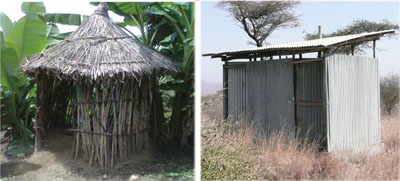2.2.2 Measures targeting the mode of transmission
The measures that can be applied to interrupt transmission of infectious agents in water, food, other vehicles and by vectors, are described below.
The detailed discussion of interventions to prevent and control all these modes of transmission can be found in the Hygiene and Environmental Health Module.
Water
Measures to prevent transmission of infection due to contaminated water include boiling the water, or adding chemicals like chlorine. Disinfection is the procedure of killing most, but not all, infectious agents outside the body by direct exposure to chemicals. Adding chlorine is one method of disinfecting water. Physical agents can also be used, for example filtering water through a box of sand, or pouring it through several layers of fine cloth. Faecal contamination of water should also be prevented by protecting water sources and through proper use of latrines (Figure 2.3).

Food
Measures to prevent transmission in contaminated food include washing raw vegetables and fruits, boiling milk, and cooking meat and other food items thoroughly before eating. Contamination with faeces can be prevented by hand washing and proper use of latrines.
Other vehicles
Measures to tackle transmission in or on vehicles other than water and food include:
- Contaminated objects like household utensils for cooking, eating and drinking should be washed with soap and water.
- Contaminated medical instruments and clothing can be sterilised, disinfected or properly disposed of.
Sterilisation involves destruction of all forms of micro-organisms by physical heat, irradiation, gas or chemical treatment. The difference between disinfection and sterilisation is that disinfection kills most, but not all, micro-organisms. Disinfection can be done using alcohol, chlorine, iodine or heating at the domestic level; whereas sterilisation has to use extreme heating, irradiation or strong chemicals like a high concentration of chlorine.
Vectors
Measures against vectors include preventing breeding of vectors, through proper disposal of faeces and other wastes, eradication of breeding sites, and disinfestation. Disinfestation is the procedure of destroying or removing small animal pests, particularly arthropods and rodents, present upon the person, the clothing, or in the environment of an individual, or on domestic animals. Disinfestation is usually achieved by using chemical or physical agents, e.g. spraying insecticides to destroy mosquitoes, and removing lice from the body and clothing.
2.2.1 Measures targeting the reservoir of infection
